Gardiner V., Matthews H. The changing geography of the United Kingdom
Подождите немного. Документ загружается.

IAN BOWLER
96
cent of all laying hens. Other enterprises, and other parts of the UK, have experienced
lower levels of concentration: in Wales, for example, the 14 per cent of largest producers
farm only 46 per cent of the beef cows.
On specialisation, the broad regional contrasts of specialisation in crop and livestock
production remain from the productionist era, with only changes in detail. Under the
increasingly competitive market conditions of the 1990s, and in common with producers
in other EU states, individual farm businesses in the UK have continued to obtain economies
of scale by specialising in a limited number of farm products. Taking some examples
from crop farming, and comparing the mid-1970s (Bowler 1982) with 1996, wheat
production remains localised in the eastern counties of England, with the area of the crop
contracting in north-east Scotland, Somerset and Hampshire (Figure 5.1). Barley, more
widely distributed than wheat throughout England and Scotland, has lost its significance
in most counties in competition with imports of livestock feed, but especially in north-
east Scotland and north-east England. The area of oilseed rape, now concentrated in east-
central England, has increased in Fife and Lothian but has decreased in the Ridings of
Yorkshire and in the East Midlands.
Similarly, regional differences in specialisation in livestock farming have continued
(Figure 5.2). Market trading in milk quotas, for example, has continued the relocation
of dairying into western parts of the UK under the forces of comparative economic
advantage, especially to the benefit of Northern Ireland, Cheshire and counties in south-
west England. During 1995/6, for example, Northern Ireland became a net gainer of
85.7 million litres of purchased quota (mainly the counties of Down and Tyrone), whereas
England suffered a net loss of 41.7 million litres (mainly West Yorkshire, Norfolk and
the West Midlands). Beef cows, although widely distributed throughout the UK, remain
most localised in Northern Ireland, the Scottish Borders and central Wales, but with
numbers reduced by the late-1990s under the slaughter programme designed to eliminate
BSE from the food chain. Sheep densities remain highest throughout Wales and northern
England, Devon and west-central Scotland; but production has spread out into the
lowlands, partly to compensate for the reduction in dairying but mainly to meet the
demand for sheepmeat on the EU market. Specialised areas of pig production have
been further consolidated in the Ridings of Yorkshire, and in Lancashire, East Anglia,
Fife, Lothian and Armagh (Figure 5.2).
Table 5.11 and Figure 5.3 summarise the impacts of these recent adjustments in UK
agriculture as regards farm-type structure. For example, the number and proportion of
specialist dairy farms declined between 1975 and 1996, with compensating gains in the
proportion of cattle and sheep farms. The latter now dominate the type of farm structure in
western counties of the UK, from Cornwall and Devon in the south-west, through Wales
and Northern Ireland, to northern England and Scotland. The proportion of cropping farms
increased slightly, to the advantage of most counties in east and central England; whereas
the relative importance of horticulture and pig and poultry farms declined, mainly through
competition with low-cost imports from other countries both inside and outside the EU.
Portents of post-productionism
Despite the continuation of many features of productionist agriculture, a number of post-
productionist trends can be identified in UK agriculture and summarised using the terms
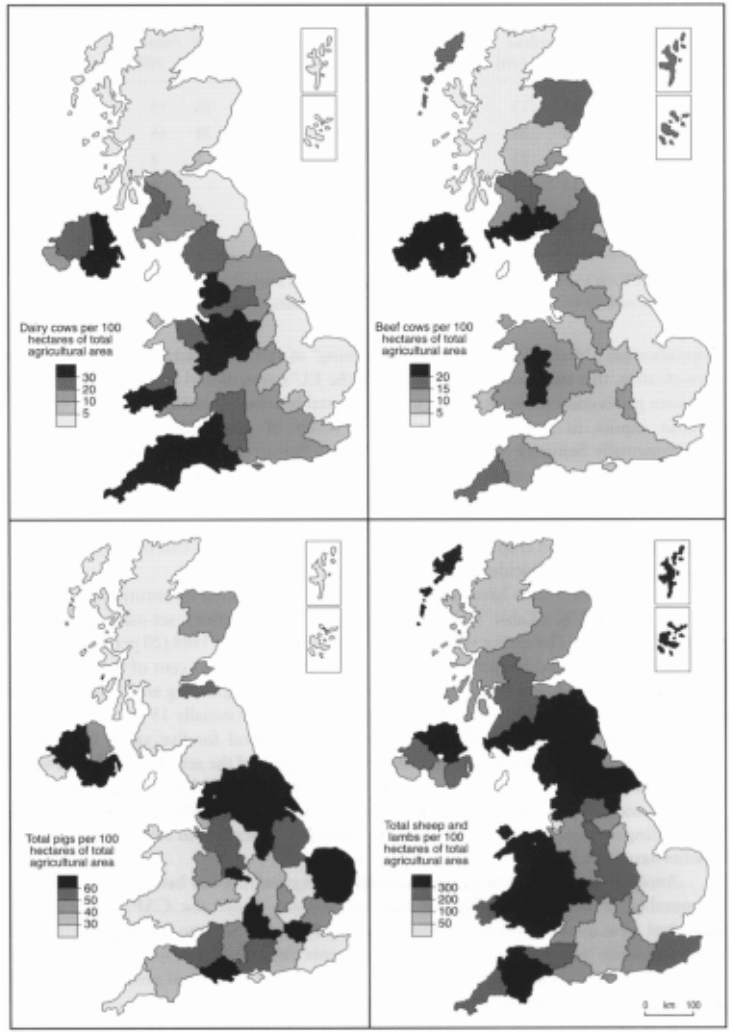
AGRICULTURE
97
FIGURE 5.2 Regional distribution of selected livestock, 1996
Sources: Agricultural Statistics, MAFF; SOAFD; DANI; WO.
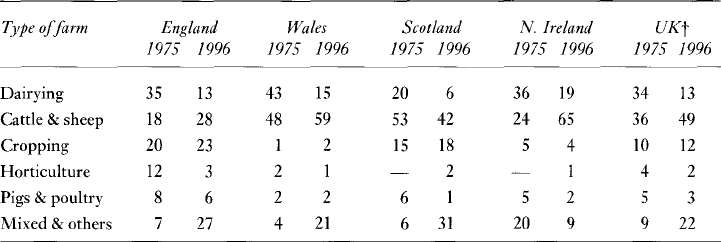
IAN BOWLER
98
‘extensification’, ‘diversification’ and the ‘greening’ of farming practices. Looking first at
extensification, this tendency is consistent with the EU’s agricultural objectives of reducing
total farm production while increasing environmental benefits. Evidence is growing of lower
fertiliser inputs to agriculture, partly as a result of grant-aided schemes such as
Environmentally Sensitive Areas (ESA) and Nitrate Sensitive Areas (NSA), and partly as a
result of the economic pressure on farmers to increase the cost-effectiveness and efficiency
of their expenditure on fertilisers. Evidence of reductions in agri-chemicals is less clear
(pesticides comprised 4 per cent of national agricultural expenditure in 1995), but the wider
acceptance of integrated crop management (ICM) practices suggests that the upward growth
in the application of herbicides and pesticides may have been checked.
These developments have been associated with a significant downturn in the area of
cropland in the UK (Table 5.12) as a result of the compulsory set-aside programme introduced
in 1993. The earlier voluntary set-aside programme of 1988 (20 per cent of arable land) had
a very limited impact within the UK: by 1992 only 4 per cent of the 1988 arable area had
been retired, and then mainly in the marginal cereal growing areas of central and southern
England. The 1993 programme, with its rotational (initially 15 per cent of arable land) and
non-rotational (initially 18 per cent of arable land for five years) options, by contrast, has
had a greater impact. The volume and location of the set-aside land follows the prior
distribution of crop farming in the eastern counties of England and Scotland. However, with
80 per cent of the land in rotational set-aside, and the percentage of arable land needing to
be set-aside falling during the 1990s (e.g. 5 per cent in 1998), environmental benefits have
been limited.
Another contribution to the extensification of agriculture has been made by capping
the number of livestock eligible for financial support under the CAP. For example, individual
farm quotas apply to the Sheep Annual Premium Scheme and the Suckler Cow Premium,
while ‘regional ceilings’ apply to payments under the Beef Special Premium and the HLCA.
Restraints have been placed on the expansion of subsidised production through these
measures, including the further over-grazing of upland pastures.
A second feature of post-productionism is the development of diversification in
agriculture; here three dimensions can be identified: farm diversification, other gainful activity
(OGA) and farm woodland. Farm diversification involves the introduction of a new, non-
TABLE 5.11 Type of farm structure in the UK, 1975 and 1996 (per cent full-time farms)*
Source: MAFF/SOAFD/DANI/WO, Digest of Agricultural Census Statistics (various years), HMSO.
Notes: *Definitions vary in detail over time and between counties; †Rounding errors.
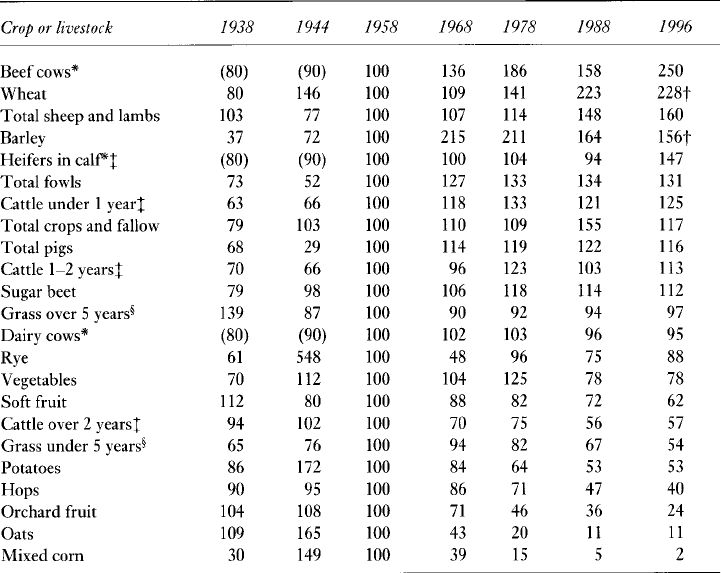
AGRICULTURE
99
traditional enterprise into the farm business, resulting in a redeployment of land, labour and
capital. A distinction is often drawn between agricultural and non-agricultural diversification,
the former including new crops or livestock, such as linseed and deer respectively. Non-
agricultural diversification includes enterprises that add value to products on the farm (e.g.
farm-made yoghurts and cheeses), direct marketing (e.g. pick-your-own crops and farm
shops), farm accommodation, recreational activities (e.g. sport fishing and horse livery),
and catering services (e.g. farm restaurants). Farm diversification has been grant-aided in
the UK under the Alternative Land Use and the Rural Economy (ALURE) programme, and
more specifically through the Farm Diversification Grant Scheme (FDGS), between 1988
and 1993. In the UK, diversification has affected approximately 20 per cent of farms but
more so in the urban fringes of large urban centres (for instance, London and Birmingham
where market opportunities exist in serving urban consumers), and in areas favoured by
tourism (for instance, agricultural areas in the south-west and north-east of England). Under
the FDGS, farm tourism was the most important enterprise to be developed, with such
diversification greatest in the north-east, south-east and south-west counties of England.
TABLE 5.12 UK agricultural trends in selected crops and livestock, 1938–96 (crop areas or livestock
numbers as per cent of 1958)
Source: MAFF/SOAFD/DANI/WO, Digest of Agricultural Census Statistics (various years), HMSO.
Notes: *Before 1960, beef cows, dairy cows and heifers in calf were collected together; †1997; ‡Dairy
and beef livestock; §Changed census definitions in 1959 and 1975.
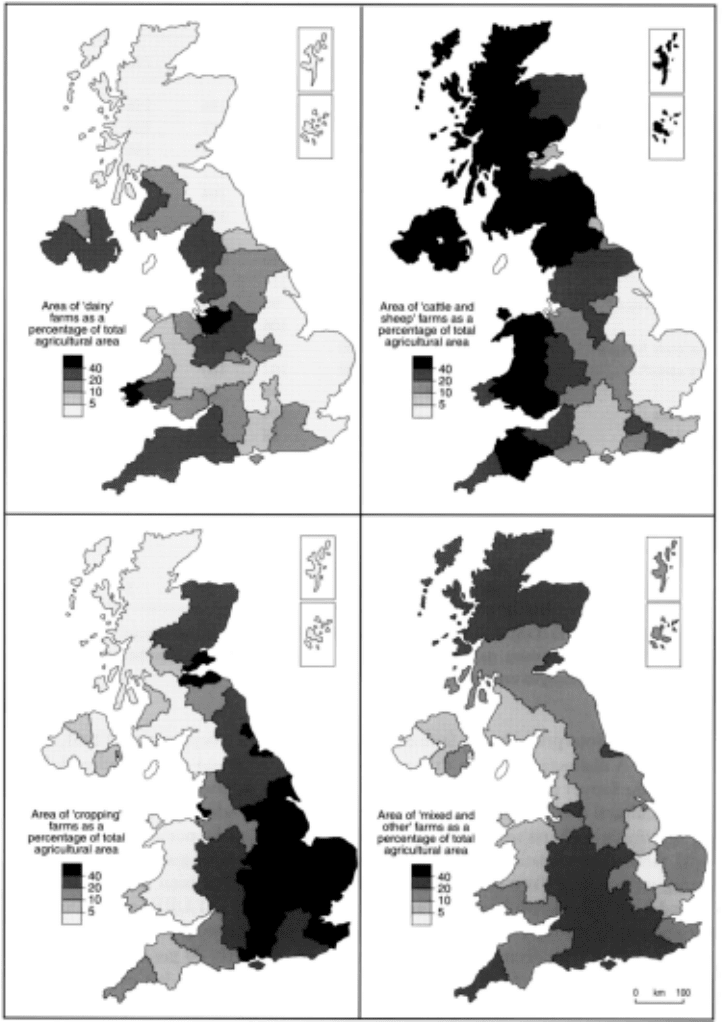
IAN BOWLER
100
FIGURE 5.3 Regional distribution of selected types of farming, 1996
Sources: Agricultural Statistics, MAFF; SOAFD; DANI; WO.
AGRICULTURE
101
But the process of farm diversification has been socially selective to the advantage of younger,
better educated and trained farmers, farm families in which farm women have become
involved in managing the farm business, and larger farms where there is greater access to,
and ability to finance, borrowed capital. The increased importance of ‘mixed’ farming in
the type of farm structure of the UK, especially in south and central England (Table 5.11
and Figure 5.3), provides an indication of greater agricultural diversification, although the
category also reflects the introduction of additional but traditional enterprises onto formerly
specialist farms in the 1990s (e.g. beef onto cropping farms or sheep onto dairy farms).
Seeking employment away from the farm (OGA) is increasingly important, partly as
a survival strategy amongst farm families on smaller farms but partly as a means of personal
development or capital accumulation on larger farms. Approximately 24 and 29 per cent of
adult males and females, respectively, in UK farm families appear to be involved in OGA,
together providing a conservative estimate that one-third of farm households have a second
source of earned income. This percentage increases in areas adjacent to urban-based
employment opportunities and in peripheral regions where multiple job holding is a cultural
tradition, for instance in the Highlands of Scotland. Depending on their educational
qualifications and non-farming skills, both men and women gain employment in a wide
range of occupations, varying from jobs in services, factories and offices, through professional
occupations such as teaching and nursing, to management in companies sometimes owned
by the farm family. On almost half of smaller farms, OGA compensates for low farm incomes
and is significant in enabling them to survive as businesses. Indeed on a majority of farms
with OGA, half or more of the family income is generated by off-farm work and forms an
important component of the diversification of agriculture. Nevertheless, it is important to
recognise that nearly half of farmers with OGA have entered agriculture from a non-farming
background, so that taking an off-farm job is more than a survival strategy by ‘traditional’
farm families.
Farm woodland provides the third example of diversification in agriculture. Although
often identified as the main alternative use for ‘surplus’ farmland, farm woodland shows
only a modest and spatially uneven development in the UK over the last decade, despite
financial incentives from the state. For example, grant aid has been available to farmers
for planting, managing, compensating for loss of agricultural income and improving farm
woodland under a succession of schemes, including the 1988 Farm Woodland Scheme
(£10 million from MAFF under ALURE) and the Woodland Grant Scheme (Forestry
Commission), the non-rotational element of the 1988 and 1993 set-aside programmes,
and the 1992 Farm Woodland Premium Scheme (under EU Regulation 2080/92). Entry
into these schemes has been voluntary for participating farmers and has favoured younger,
better-educated farmers in the central counties of England, especially in localities having
a tradition of farm woodland. The limited development of farm woodland is illustrated by
the 14,000 hectares planted out of a target of 36,000 hectares under the 1988 Farm
Woodland Scheme, although most of the trees were broadleaf varieties (oak, ash and
beech). At issue is the setting of grant aid at too low a level to compensate farmers for
‘lost’ agricultural production, the long payback time of the investment, and inexperience
with farming woodland.
The third dimension of post-productionism is the ‘greening’ of farming practices,
and two main features can be identified as regards how farming is practised: the development
of organic farming and farmer response to state-aided agri-environmental schemes. Organic
IAN BOWLER
102
farming implies production without inorganic fertilisers, agri-chemicals and intensive
livestock techniques and it has developed to a lesser extent in the UK compared with
many other European countries. On the one hand, the growth in consumer demand for
organic produce has not been as great as anticipated, despite a number of surveys showing
consumer support for such food. In practice, consumers have been resistant to the price
premium placed on organic farm produce, with multiple retailers in turn proving cautious
in marketing organic produce because of its lower turnover on supermarket shelves. On
the other hand, potential producers have been unsure of the economic returns to be obtained
from organic as compared with conventional crop and livestock production. In addition
there has been an ‘income gap’ during the two-year conversion period from conventional
to organic production, although this has been partly addressed by the Organic Scheme
introduced under the AEP. The marketing problem for producers has been compounded
by retailers importing lower-cost organic produce from other European countries. The
outcome for organic farming in the UK is a concentration of development on small farms
in west Wales, the Vale of Evesham and Sussex, and on larger crop farms scattered
throughout eastern England.
On agri-environmental schemes to stimulate the ‘greening’ of farming practices, the
UK took a lead in the EU in developing the concept of ESA, introduced into the EU in 1985
under Regulation 797/85 (Article 19) and into the UK under the 1986 Agriculture Act. For
England, five ESA were designated in 1986/7 and a further seventeen by 1994. In common
with all agri-environmental schemes to date, participation by farmers has been voluntary,
producing an uneven pattern of involvement. By 1995, ten-year management agreements
had been reached with 7,700 farmers, covering an area of 400,000 hectares. Research in the
ESAs has found that the annual payments to farmers succeed in reducing levels of fertiliser
use, lead to pasture management practices that are more sensitive to wildlife, especially
ground-nesting birds, have little effect on pre-existing livestock densities, but maintain
landscape features such as field barns, walls and hedges. In 1989, the Farm and Conservation
Grant Scheme provided grant aid for capital works on hedges, stone walls, shelter belts,
repairs to traditional buildings and farm waste handling facilities. Also in 1989, a Countryside
Premium (for set-aside land) scheme was introduced into seven counties in eastern England:
this scheme was funded by £13 million over three years from the Department of the
Environment (DoE) and aimed at grant-aiding crop farmers in wildlife and landscape
management. A national Countryside Stewardship (Pilot) Scheme funded by the Countryside
Commission followed in 1991 (upgraded to a full scheme by MAFF in 1996), with grant
aid this time helping farmers (re)create environmental features such as riverside water
meadows, lowland heath, chalk and limestone grassland, moorlands and coastal vegetation
in ‘target landscapes’. By 1996, over 5,000 management agreements were in place at a cost
of £11.7 million each year. A parallel Tir-Cymen Scheme has operated in Wales under the
aegis of the Countryside Council for Wales. The UK has also taken part in the EU’s
programme to reduce goundwater pollution from farm fertilisers (Directive 91/676) through
the designation often (pilot) nitrate sensitive areas (NSA); twenty-two further NSA were
designated in 1994 with financial compensation available to farmers who agreed to change
their farming practices over a five-year period so as to reduce nitrate leaching. Most recently,
grant aid has been provided under the UK’s AEP under titles such as the Habitat Improvement,
Moorland, Organic and Countryside Access Schemes, but with consequences that have yet
to be fully researched. Taking the UK as a whole, these agri-environmental schemes have
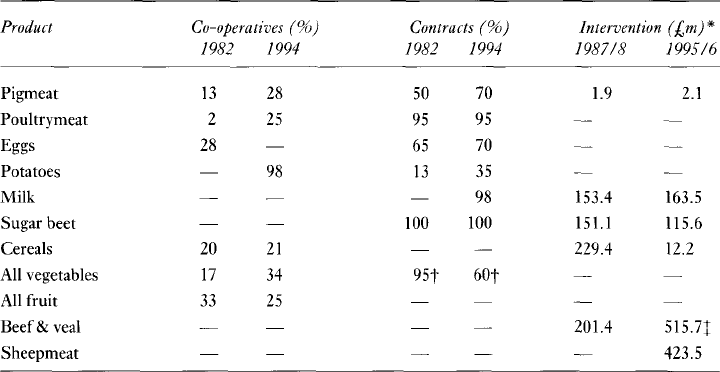
AGRICULTURE
103
had only marginal impacts on farming practices and environmental outcomes. As shown by
Battershill and Gilg (1996) and Potter (1997), such impacts are confined to a limited range
of farming areas and individual farms, where pro-conservation attitudes of farmers and a
commitment to ‘traditional’ farming act selectively on farmers participating voluntarily in
the schemes.
Developments in agricultural marketing
An important feature of the third food regime is the further transformation of how food is
marketed to the consumer. Marketing at the farm gate, as well as down the marketing chain,
is being affected by a further tightening of control by non-farm capitals in the food processing
and retailing sectors, and also by an increasing reaction to such control by both farmers and
consumers.
Looking first at the role of the EU, intervention agencies under the CAP still underpin
the market for the main agricultural products. In the UK, the Intervention Board for
Agricultural Produce acts as the agent of the EU by purchasing, storing and subsequently
marketing surplus farm products, often through subsidised exports. Considerable sums of
money are expended, despite a general reduction in price support levels. Whereas expenditure
under the CAP on cereals, and to a lesser extent sugar beet, has fallen considerably under
the revised 1992 pricing arrangements (see pp. 86–7), greatly increased expenditure is evident
in the marketing of sheepmeat and beef/veal (Table 5.13).
The significance of food processors in UK agriculture, as established during the second
food regime, has continued into the 1990s. Most food reaching the consumer is subject to
some form of industrial processing, including washing, grading and packaging. For example,
TABLE 5.13 UK agricultural marketing of selected products through co-operatives, contracts and
CAP intervention, 1982–94
Source: Commission of the European Communities, The Agricultural Situation in the Community—
Report (various years), Office for Official Publications of the European Communities.
Notes: *Expenditure by the Intervention Board for Agricultural Produce; †Peas; ‡Non-BSE.
IAN BOWLER
104
until recently the Milk Marketing Board for England and Wales (now Milk Marque Limited)
controlled over 75 per cent of manufacturing capacity for butter and 50 per cent of the
capacity for hard-pressed cheese. In common with other parts of the manufacturing sector,
food processing companies have experienced downsizing and restructuring in recent years;
sectors showing the highest levels of concentration (i.e. fewest competing firms) are
brewing, biscuits, margarine, starch and bread/flour; the least concentrated are animal/
poultry food and vegetable/animal oils and fats. Most companies hold back from direct
ownership of farms, finding it more cost-effective to obtain their raw materials through
forward production contracts placed with a small number of larger producers, including
farmer co-operatives. By the mid-1990s, for example, all sugar beet, 98 per cent of milk,
95 per cent of poultrymeat and 70 per cent of eggs and pigmeat were produced under
contract (Table 5.13). In these circumstances, nearness to the relevant processing factory
has become an important factor in the location of production. At present most UK food
processors obtain their raw materials from domestic producers or from within the EU;
however, the prospective enlargement of the EU could well widen the area over which
UK food processors place their contracts.
By far the most significant development in the marketing of farm products in the
1970s and 1980s, however, was the growth in the economic power of a relatively few but
large multiple retailers through their chains of supermarkets (Wrigley 1987). By the early
1990s, large food retailers such as Sainsbury (approximately 18 per cent of market share),
Tesco (15 per cent), Gateway (13 per cent), the Co-op (12 per cent) and ASDA (8 per cent),
dominated food sales to consumers, becoming the price setters for the products of the food
processing sector. Those prices then influenced price levels in contracts offered to farmers
by individual food processors. In addition, large multiple retailers are able to offer contracts
directly to those larger farm businesses and farmer co-operatives which can meet exacting
standards of volume, quality, timeliness, price and packaging for certain products—for
instance potatoes and eggs. By the mid-1990s, the top six retailers controlled 86 per cent of
the grocery market in the UK, leading to the further demise of the small grocer and
greengrocer in urban and rural areas alike.
So as to obtain a degree of ‘countervailing power’, farmers with larger businesses
continue to group together to develop marketing co-operatives for their contract negotiations
with food processors and retailers. By offering a product of the necessary assured quantity
and quality, farmer co-operatives attempt to negotiate more favourable contract prices,
although with variable results. Probably of greater importance for the economics of individual
farm businesses is the passing of responsibility for marketing from the individual farmer to
the specialised staff of the co-operative. Potatoes, vegetables, pigmeat, fruit and poultrymeat
are the products most associated with the development of co-operative marketing in the
1990s (Table 5.13). The distribution of farmer co-operatives around the UK reflects the
prior regional location of these different products (Bowler 1982:96).
Many smaller farmers, however, are seeking other ways of by-passing the marketing
chain and gaining direct access to consumers, thereby achieving a higher price for their
products. For example, experience in the 1980s with the development of pick-your-own
and farm shops (Bowler 1982:96) is being extended to the development of farmers’ markets,
as found already in North America. In the organic farming sector, smaller producers are
selling their fruit, vegetable and livestock products locally through retail outlets or
increasingly popular ‘vegebox’ schemes. Under this latter system a network of local
AGRICULTURE
105
customers pay a fixed amount to an organic producer to receive a weekly box of seasonal
fruit and vegetables. Other smaller producers are addressing a further aspect of ‘green’
consumerism, namely the increasing niche market for speciality or ‘quality’ foods, such as
farm cheeses, yoghurts and meat products. These markets tend to be local in extent and
supplied mainly through retailers. Producers are having to group together to be able to
advertise and supply larger regional and national markets.
Multiple retailers have responded to the commercial potential of ‘green’ consumerism
by introducing organic and ‘conservation grade’ foods into their stores and developing
networks of farmers who are able to comply with their own schemes of assurance as regards
food safety, including the traceability of food products. Competition under the third food
regime between farmers and food retailers for the growing number of ‘green’ consumers is
underway.
Conclusion
Two concluding observations can be made as regards the likely condition of UK
agriculture in the early decades of the next millennium. First, just as a spatially
differentiated agriculture developed under the productionist imperatives of the second
food regime, so varying regional combinations of productionist and post-productionist
agricultural trends will continue to evolve within the UK. How far and how fast such
trends as the increased extensification, diversification and ‘greening’ of farming practices
and structures take place will be conditioned in large part by the next round of reforms
to the CAP (‘Agenda 2000’), the further enlargement of the EU, and the WTO
negotiations of 2002/3. The promised deepening and extension of the 1992 reforms,
especially the further scaling down and decoupling of financial support from production,
seem likely to strengthen the development of post-productionist over productionist
developments in agriculture.
Second, just as agriculture is subject to its own ‘internal’ restructuring, so the sector is
coming under increasing ‘external’ pressures from other users of rural land, including urban,
recreation, tourism and conservation interests. A number of different regional contexts have
been identified in this restructuring of rural space (Marsden 1997), including ‘preserved’,
‘contested’, ‘paternalistic’ and ‘clientelist’ countrysides. The economic and social roles of
agriculture will vary within and between such new rural spaces: in particular farm production
could become increasingly concentrated within the UK in the most productive areas as
regards climate, soil and large-farm structure, with farming in the remaining ‘marginalised’
areas oriented more towards housing, recreation, tourism and conservation functions. In
these circumstances, agriculture’s place in the economy and society will be interpreted
increasingly within the wider processes of rural development and in regional (i.e. endogenous)
rather than national and international (i.e. exogenous) contexts.
References
Battershill, M. and Gilg, A. (1996) ‘Environmentally friendly farming in south west England’, in N.
Curry and S.Owen (eds) Changing Rural Policy in Britain, 200–24, Cheltenham: Countryside &
Community Press.
Bowler, I.R. (1979) Government and Agriculture: a Spatial Perspective, Harlow: Longman.
